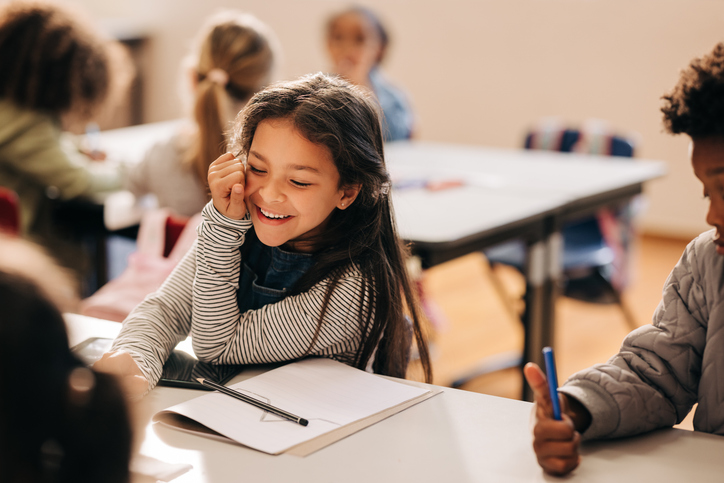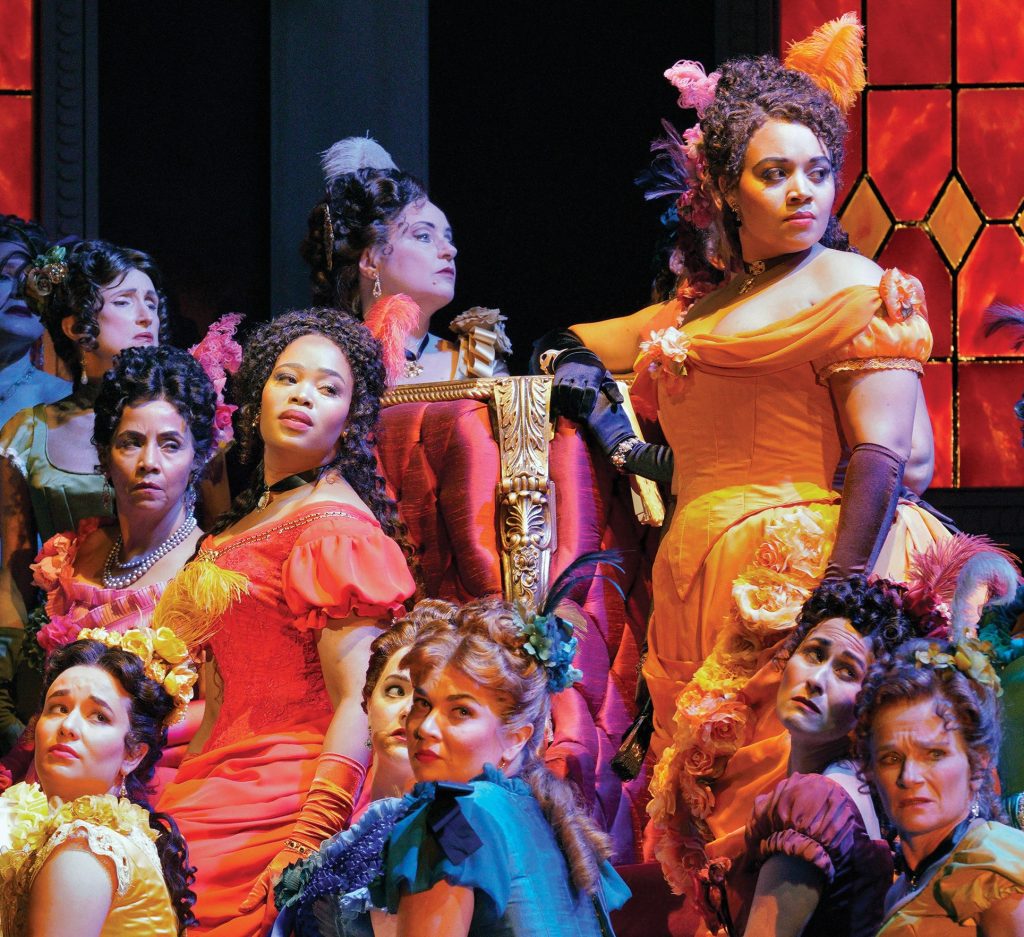Dual language education (DLE) programs are uniquely positioned to be models of culturally and linguistically sustaining pedagogy that can shape instruction of multilingual language learners nationally. However, to achieve this goal, DLE programs must prioritize a culturally responsive framework.
Here’s a short scenario to set the stage for the topic and briefly define culturally responsive teaching, sharing why it is a critical framework for multilingual learners in DLE programs.
Scenario: A Spanish–English dual language immersion program in an urban elementary school uses a 50/50 model with Spanish and English integrated equally throughout the curriculum. The program strives for an equal ratio of native English speakers and native Spanish speakers. However, the reality is that many of the students coming from Spanish-speaking backgrounds were born in the US and have stronger English language skills than Spanish skills. The math curricular units alternate between Spanish and English. However, during small-group math discussions, students are given the option to speak in their preferred language. Because English is the dominant language for the majority of the students, almost all of the small-group discussions occur in English. Ms. Torres, the English language development (ELD) teacher, has noted that frequently the Spanish-speaking students who are recent arrivals to the US and are in the process of acquiring English remain quiet during these math discussions. She understands the importance of giving students choice in their language use, but she also wants to provide some recommendations to teachers on how to engage this particular group of multilingual learners more effectively in mathematical discussions with their peers.
• Viewing this scenario through the lens of cultural and linguistic equity, what stands out to you?
• What advice might you offer the ELD teacher?
As you can see in this scenario, even within a program committed to educating multicultural and multilingual students, there can be areas of inequity for multilingual learners and a need to strengthen culturally responsive teaching practices.
What is culturally responsive teaching and why is it important?
Culturally responsive teaching is an educational framework that is centered on recognizing, valuing, building on, and sustaining the cultural and linguistic experiences of students of color who have been historically underserved by US educational systems (Ladson-Billings, 1992, 1995; Gay, 2002, 2010; Paris and Alim, 2017). Ladson-Billings (1992, 1995) coined the term culturally relevant pedagogy to characterize an instructional framework that aims to empower culturally and linguistically diverse students on intellectual, social, emotional, and political levels. The goal of this framework is to integrate students’ cultural references into all aspects of education, set high expectations for students, and develop students’ skills in being able to identify and challenge social inequities (Ladson-Billings, 1992, 1995). Gay (2010) used the term culturally responsive teaching to describe an approach that uses “cultural knowledge, prior experiences, frames of reference, and performance styles” to make learning more meaningful for culturally and linguistically diverse students (p. 31).
Expanding on this concept, Paris and Alim (2017) argue for a culturally sustaining pedagogy that nurtures students’ cultural practices by intentionally and systematically integrating students’ languages and cultural identities into lessons and curricular units, based on conversations with students and families about what aspects of culture they want to sustain through their schooling. Paris and Alim explain that a priority of culturally sustaining pedagogy is to support students in making meaningful connections between what they are learning and the histories of racial, ethnic, and linguistic communities (Ferlazzo, 2017).
Not only is culturally responsive teaching a way to make learning more meaningful for multilingual learners, it is also a way to strengthen two essential components of dual language education: sociocultural competence and critical consciousness (Soto et al., 2023). Howard et al. (2018) describe sociocultural consciousness as “a term encompassing identity development, cross-cultural competence, and multicultural appreciation—for all students” (p. 3).
Critical consciousness is the ability to analyze social systems in order to identify inequities and to commit to taking action against these inequities (Freire, 1970; Ladson-Billings, 1992). Palmer et al. (2019) have been vocal advocates for actions that foster critical consciousness among teachers, parents, and students in dual language programs. Accordingly, culturally responsive teaching can be a useful framework for considering what it looks like to nurture sociocultural competence and critical consciousness in practice in dual language programs.
What practices support culturally responsive teaching?
To embed culturally responsive teaching in DLE programs, it is essential to know what this framework looks like in practice. Please take a moment to think about your educational context.
• What culturally responsive and sustaining practices are already in place?
• What could be improved upon?
To assist educators in reflecting on what it might look like to bring the theory of culturally responsive teaching into practice, Dr. Diane Staehr Fenner and I developed five guiding principles of culturally responsive teaching for multilingual learners framed around research on this topic. In our book Culturally Responsive Teaching for Multilingual Learners: Tools for Equity (2021), we included possible look-fors for each guiding principle. In Chapter 2 of Breaking Down the Monolingual Wall, I adapted these guiding principles and identified new look-fors to focus on the urgent needs of DLE programs.
What are the five guiding principles for culturally responsive teaching in dual language education programs?
Culturally responsive teaching is assets-based and grounded in a framework of cultural and linguistic equity (Snyder and Staehr Fenner, 2021; Soto et al., 2023). Guiding Principle 1 is the foundation for all our work with multilingual learners and calls on educators to learn about and develop relationships with students and their families in order to recognize and build on the cultural and linguistic assets that they bring. This first guiding principle is also an invitation to educators in dual language programs to identify areas of inequity for multilingual learners and to work to challenge these inequities.
For example, in your program, is one language integrated more frequently into instruction? In your school or district, are multilingual learners in the DLE program equitably represented in honors classes and/or gifted programming? Our tool Exploring Inequity in My Context (Snyder and Staehr Fenner, 2021, pp. 69–70) might be a helpful lens to examine possible inequities in your context.
Culturally responsive teaching simultaneously supports and challenges students (Snyder and Staehr Fenner, 2021; Soto et al., 2023). Guiding Principle 2 speaks to the importance of providing multilingual learners in dual language programs with access to challenging grade-level content while at the same time giving them the scaffolded support (e.g., modeling, visuals) that they need to engage with academic content in both languages and develop academic language. Additionally, this guiding principle advocates for instruction that offers multiple perspectives on a topic and fosters the development of critical consciousness. For example, students might analyze the national shift from celebrating Columbus Day to celebrating Indigenous Peoples Day and have an opportunity to discuss the debate around this shift in both English and the partner language using scaffolded supports for academic language use.
Culturally responsive teaching puts students at the center of the learning (Snyder and Staehr Fenner, 2021; Soto et al., 2023). Guiding Principle 3 emphasizes the importance of student-centered learning with opportunities for students to engage in peer-learning activities conducted in both English and the partner language and with structures in place to support participation by multilingual learners.
Guiding Principle 3 also identifies the need to engage students in goal-setting and self-assessment through the use of student checklists, goal-setting tools, and student conferencing. Let’s return to the opening scenario about peer learning groups for math. In that situation, Ms. Torres might propose strategic grouping of students as well as discussion routines to foster greater participation by all students.
She might model the inclusion of Spanish sentence stems to increase all students’ use of Spanish during small-group discussions, highlighting the importance of multilingual learner participation and use of their home language. She might also recommend that students have an opportunity to reflect on their language use during the discussions and set goals for strengthening their use of academic language in both languages. Our Peer Learning Activity Checklist (Staehr Fenner et al., 2024, p. 114) is a tool for considerations in designing effective peer learning activities to engage multilingual learners at varying levels of language proficiency.
Culturally responsive teaching leverages and sustains students’ cultural and linguistic backgrounds and fosters sociocultural competence (Snyder and Staehr Fenner, 2021; Soto et al., 2023). Guiding Principle 4 builds on Guiding Principle 1 and stresses the importance of having high-quality instructional materials in both languages as well as lessons and units that incorporate perspectives, experiences, and resources that resonate with multilingual learners’ experiences and backgrounds. Students should be explicitly taught patterns of language that will allow them to integrate their understanding of their home languages into their learning of the partner language and be provided with such tools as multilingual word walls, cognate exploration, and student-created bilingual dictionaries or glossaries to support learning (Escamilla et al., 2022).
Culturally responsive teaching unites students’ schools, families, and communities (Snyder and Staehr Fenner, 2021; Soto et al., 2023). Guiding Principle Five is built on the understanding that, in order to effectively foster multilingual learners’ academic and social and emotional well-being, we must collaborate with students’ families and communities.
Dual language education programs must prioritize removing barriers that stand in the way of family engagement, such as communication, timing of events, childcare, and/or transportation (Snyder and Staehr Fenner, 2021). Additionally, it is critical to make space and time for questions and concerns of multilingual families to be heard (Safir and Dugan, 2021; Palmer et al., 2019). Taking the steps to build equitable partnerships with multilingual families requires us to go beyond written surveys and offer listening sessions and focus groups held in families’ home languages and in places where they feel comfortable (Palmer et al., 2019).
Guiding Principle Five also emphasizes the importance of learning about the resources in students’ communities and building partnerships with community organizations to amplify the support that can be provided to multilingual students.
What step should I take next?
It can be challenging to know where to get started with strengthening culturally responsive teaching in your classroom, school, or district’s dual language program. Here are a couple of steps to get you started:
With a team of stakeholders (i.e., teachers, administrators, staff, ML families, students, and/or community partners), consider the extent to which your school mission espouses an assets-based perspective for all learners and a commitment to cultural and linguistic equity. Does the mission need to be strengthened in any way? Do all stakeholders understand and embrace the mission? If not, what steps can you take to support greater understanding of and commitment to the mission? Collaboratively review the Culturally Responsive School Checklist and Goal-Setting for Dual Language Programs. Based on your reflection and discussion, determine priority areas for next steps. For example, do you want to focus on strengthening equity in family and community engagement? Do you want to prioritize a review of dual-language curricular materials to increase access to materials and texts in both languages and increase representation in curricular units?
Whatever step you decide to take next, I encourage you to look for partners in your work. The challenge of strengthening culturally and linguistically sustaining practices can feel daunting. However, when you partner together on this important work, you send a message of how critical it is to create a space in which all voices are heard and valued, and you acknowledge that the entire community will be strengthened through these efforts.
References
Escamilla, K., Olsen, L., and Slavik, J. (2022). “Towards Comprehensive, Effective Literacy Policy and Instruction for English Learner/ Emergent Bilingual Students.” White paper. National Committee for Effective Literacy.
Ferlazzo, L. (2017). “Author Interview: ‘Culturally sustaining pedagogies.’” Education Week. www.edweek.org/teaching-learning/opinion-author-interview-culturally-sustaining-pedagogies/2017/07
Freire, P. (1970). Pedagogy of the Oppressed. Continuum.
Gay, G. (2010). Culturally Responsive Teaching: Theory, Research, and Practice (2nd ed.). Teachers College Press.
Gay, G. (2013). “Teaching to and through Cultural Diversity.” Curriculum Inquiry, 43(1), 48–70.
Howard, E. R., Lindholm-Leary, K. J., Rogers, D., Olague, N., Medina, J., Kennedy, B., Sugarman, J., and Christian, D. (2018). Guiding Principles for Dual Language Education (3rd ed.). Center for Applied Linguistics.
Ladson-Billings, G. (1992). “Reading between the Lines and beyond the Pages: A culturally relevant approach to literacy teaching.” Theory into Practice, 31(4), 312–320.
Ladson-Billings, G. (1995). “Toward a Theory of Culturally Relevant Pedagogy.” American Research Journal, 32(3), 465–491.
Ladson-Billings, G. (2004). “New Directions in Multicultural Education: Complexities, boundaries, and critical race theory.” In J. A. Banks and C. A. M. Banks (Eds.), Handbook of Research on Multicultural Education (2nd ed., pp. 50–65). Jossey Bass.
Palmer, D., Cervantes-Soon, Dorner, L., and Heiman, D. (2019). “Bilingualism, Biliteracy, Biculturalism, and Critical Consciousness for All: Proposing a fourth fundamental goal for two-way dual language education.” Theory into Practice, 58(2), 121–133.
Paris, D., and Alim, H. S. (2017). Culturally Sustaining Pedagogies: Teaching and Learning for Justice in a Changing World. Teachers College Press.
Safir, S., and Dugan, J. (2021). Street Data: A Next-Generation Model for Equity, Pedagogy, and School Transformation. Corwin.
Snyder, S., and Staehr Fenner, D. (2021) Culturally Responsive Teaching for Multilingual Learners: Tools for Equity. Corwin.
Soto, I., Snyder, S., Calderón, M., Gottlieb, M., Honigsfeld, A., Lachance, J., Marshall, M., Nungaray, D., Flores, R., and Scott, L. (2023). Breaking Down the Monolingual Wall: Essential Shifts for Multilingual Learners’ Success. Corwin.
Staehr Fenner, D., Snyder, S., and Gregoire-Smith, M. (2024). Unlocking Multilingual Learners’ Potential: Strategies for Making Content Accessible (2nd ed.). Corwin.
Sydney Snyder, PhD, is a principal associate at SupportEd (https://supported.com), a woman-owned small business dedicated to advocacy and educational equity for multilingual learners and their families. In this role, she provides professional development, coaching, and technical assistance to organizations, districts, and educators in support of multilingual learners and their families.
She is the co-author of Unlocking Multilingual Learners’ Potential: Strategies for Making Content Accessible, Culturally Responsive Teaching for Multilingual Learners: Tools for Equity, and Breaking Down the Monolingual Wall: Essential Shifts for Multilingual Learners’ Success.
You can connect with her at [email protected].














